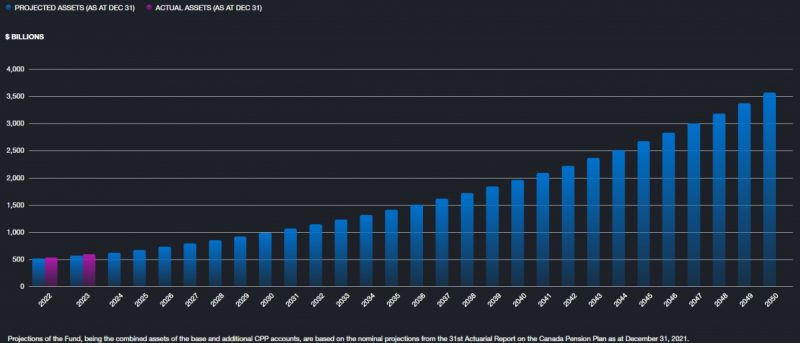Canadian pension funds urged to boost domestic investments
A recent development with Canada Pension Plan (CPP) has sparked attention across Canada’s financial landscape.
Around 100 prominent Canadian business leaders have united to advocate for a significant adjustment in the investment strategies of the nation’s pension plans.
Their collective voice, expressed through an open letter addressed to Finance Minister Chrystia Freeland, emphasized the importance of encouraging Canadian pension funds to redirect more of their capital towards investments within the country’s borders.
The key message conveyed by these influential figures is not a call for stringent restrictions but rather a plea for a nuanced alteration in the regulatory framework. Instead of imposing a hard cap on investments made abroad, the signatories propose a subtle adjustment to the rules, designed to incentivize major pension plans such as the CPP to allocate a greater portion of their resources towards Canadian enterprises and projects.
One of the driving forces behind this initiative is Letko Brosseau & Associates, a reputable money management firm based in Montreal. The firm has previously expressed concerns over the diminishing proportion of capital that Canada’s major pension plans deploy within the domestic market. According to the open letter, the eight largest pension plans in Canada currently hold more assets invested in China than they do in their own country, a statistic that underscores the urgency of the situation.
Minister Freeland told reporters that Canadian pension funds are “one of the crown jewels of our country” and confirmed that she spoke to the fund leaders about how to “encourage” domestic investment.
“We said that we were committed as a government to working collaboratively with Canada’s pension funds to help them find more opportunities to invest here in Canada, our remarkable country,” she said.
Freeland met with executives from Canada’s nine largest pension funds in early March as the Liberal party prepares its 2024 budget, set to be tabled on April 16.
Why this matters
The significance of this movement extends beyond mere economic considerations; it reflects a broader narrative surrounding the role of institutional investors in shaping the trajectory of the Canadian economy. By advocating for a recalibration of investment strategies, the signatories are striving to bolster domestic industries, foster innovation, and fortify the nation’s economic resilience.
One notable development that aligns with this call for increased domestic investment is the recent decision by the Canada Pension Plan Investment Board (CPPIB) to reduce its presence in China. Reports indicate that CPPIB has downsized approximately 10 percent of its Hong Kong-based staff focused on Chinese equities. While this adjustment might seem modest in numerical terms, its symbolic significance resonates within the context of broader trends observed among Canadian pension plans.
The CPPIB’s move follows similar actions taken by other major pension funds in Canada, including the Ontario Teachers Pension Plan and British Columbia’s public pension manager. These decisions underscore a growing sentiment among institutional investors to reassess their exposure to Chinese markets, particularly in light of recent economic challenges faced by the country.
Background on CPP investments
CPP is one of Canada’s most significant social programs, designed to provide retirement, disability, and survivor benefits to eligible contributors and their families. However, what many Canadians might not realize is that the CPP also involves a robust investment strategy managed by the CPPIB.
The CPPIB is responsible for investing CPP funds not needed to pay current benefits, with the aim of maximizing returns without undue risk. Established in 1997, the CPPIB operates at arm’s length from the government and reports to Parliament through the Minister of Finance. Its mandate is to invest in various asset classes globally to help ensure the long-term sustainability of the CPP.
Major Canadian pension funds include CPP investments, Caisse de dépôt et placement du Québec (CDPQ) and the Ontario Teachers’ Pension Plan (OTPP), among others.
Asset classes and investment strategy
The CPPIB invests across several asset classes, including active equities, capital markets, credit investments, private equity and real assets. This diversified approach aims to mitigate risks and optimize returns over the long term.
- Active equities: This asset class involves investments in publicly traded companies where the CPPIB takes an active role in managing investments to generate returns.
- Capital markets: CPPIB invests in a wide range of financial instruments, including fixed income securities, currencies and derivatives, to capitalize on global market opportunities.
- Credit investments: CPPIB’s credit investments include debt securities, loans and other credit-related instruments, offering stable returns with moderate risk exposure.
- Private equity: This asset class involves investments in privately held companies, providing opportunities for significant long-term growth and diversification.
- Real assets: CPPIB invests in tangible assets such as real estate, infrastructure, and natural resources, which offer inflation protection and steady income streams.
Financial sustainability of the fund
The most recent triennial report by the Chief Actuary of Canada confirmed that the CPP is financially sustainable for the next 75 years.

Notable holdings and valuations (2023)
With C$590.8 billion in the fund as of Dec. 31, 2023, the most recent triennial report by the Chief Actuary of Canada confirmed that the CPP is financially sustainable for the next 75 years.
According to the CPPIB’s 2023 annual report, some of its notable Canadian investments and their valuations include:
- Active equities: CPPIB holds significant positions in leading Canadian companies across various sectors, contributing to the growth and stability of the fund. Specific valuations and holdings can be found in the CPPIB’s Annual Report.
- Capital markets: The CPPIB’s investments in Canadian capital markets encompass a diverse range of securities, reflecting its commitment to maximizing returns while managing risk.
- Credit investments: CPPIB’s credit investments in Canada include corporate bonds, loans, and other debt instruments, providing stable income and diversification benefits. By applying the fund’s structural capabilities – long horizon, certainty of assets and scale – and its developed sources of unique insights, CPP investments can identify opportunities that other market participants overlook or miss.
- Private equity: CPPIB has made substantial investments in North American private equity opportunities, supporting the growth and expansion of domestic companies. Some of the more popular holdings include Google parent Alphabet Inc. (NASDAQ:GOOG) and NVIDIA Corp. (NASDAQ:NVDA).
- Real assets: CPPIB’s real assets portfolio in Canada comprises investments in infrastructure projects, real estate developments, and natural resource assets, contributing to economic growth and development. For example, CPP has invested C$2.25 billion into Enbridge (TSX:ENB) since 2018.
The open market impact and beyond
The implications of these developments extend beyond the realm of finance; they signal a potential shift in the geopolitical landscape as well. As major Canadian pension plans scale back their investments in China, the global dynamics of capital flows are likely to undergo significant changes, with potential ramifications for Canadian and international markets.
While the ultimate impact of these initiatives remains to be seen, one thing is clear: The call for increased domestic investment by Canadian pensions represents a pivotal moment in the evolution of the country’s financial ecosystem. As stakeholders continue to engage in dialogue and policymakers deliberate on potential reforms, the outcomes of these deliberations will shape the trajectory of Canada’s economic future. In a world of evolving uncertainties, this movement stands as a beacon of proactive engagement and collective action towards a more robust and resilient financial landscape.
Parting thoughts
The CPP’s investment strategy plays a vital role in ensuring the long-term sustainability of the CPP. Through diversified investments across various asset classes, the CPPIB aims to generate optimal returns while effectively managing risk. As of 2023, the CPPIB continues to demonstrate strong performance, with notable holdings in Canadian companies and assets across different sectors. Overall, the CPP’s investment approach underscores its commitment to securing the financial future of all Canadians.
Join the discussion: Find out what everybody’s saying about activity among the financial sector on Stockhouse’s stock forums and message boards.
The material provided in this article is for information only and should not be treated as investment advice. For full disclaimer information, please click here.






